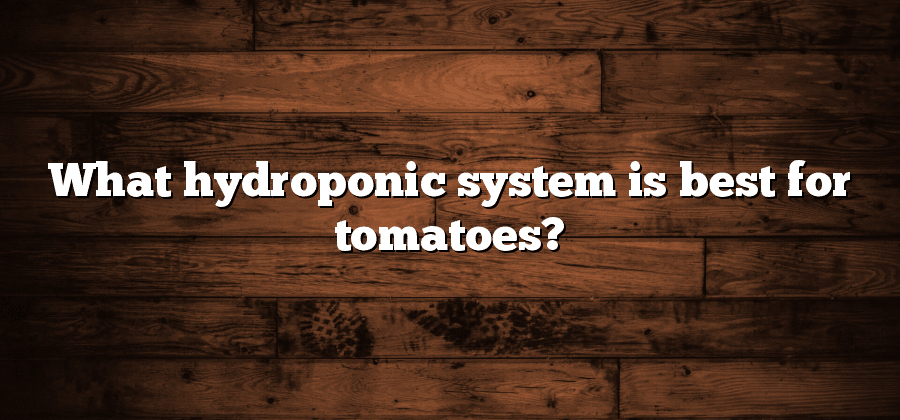Nutrient Film Technique (NFT)
The Nutrient Film Technique (NFT) is a popular hydroponic system that is widely used by both commercial growers and hobbyists. In this system, a thin film or layer of nutrient-rich water flows continuously over the roots of the plants, providing them with the necessary water and nutrients for growth.
One of the key advantages of the NFT system is its efficiency in water and nutrient usage. Since the water is constantly flowing, it allows for a more efficient uptake of nutrients by the plants, resulting in faster growth rates and higher yields. Additionally, the reduced water usage compared to traditional soil-based farming makes NFT a more sustainable and environmentally friendly option. Furthermore, the NFT system is relatively easy to set up and maintain, making it suitable for beginners in hydroponics. However, proper monitoring and adjustment of the nutrient solution’s pH and nutrient levels are crucial to ensure optimal plant growth and prevent any imbalances that could be detrimental to the plants.
Deep Water Culture (DWC)
Deep Water Culture (DWC) is a popular hydroponic system that harnesses the power of water to grow plants in a controlled environment. This system utilizes a reservoir filled with nutrient-rich water, in which the roots of the plants are suspended. The roots are constantly submerged in the water, ensuring that they have continuous access to the necessary nutrients for optimum growth.
One of the main advantages of the Deep Water Culture (DWC) system is its simplicity. It requires minimal equipment and is relatively easy to set up and maintain. The plants’ roots are exposed to high levels of oxygen as they dangle in the water, which promotes rapid and healthy growth. Additionally, the large volume of water acts as a stabilizer, helping to maintain a stable pH level and preventing nutrient imbalances. This makes Deep Water Culture (DWC) an ideal choice for both beginner hydroponic growers and experienced gardeners looking for an efficient and effective method of cultivation.
Drip Irrigation System
Drip irrigation system, also known as micro-irrigation, is a popular and efficient method used in modern agriculture. It involves the slow and precise delivery of water directly to the roots of plants, using a network of tubes and emitters. This method significantly reduces water usage and minimizes the risk of soil erosion and evaporation. Drip irrigation systems ensure that water is delivered in small, consistent amounts, promoting healthier plant growth and reducing the risk of disease.
One of the major advantages of drip irrigation is its flexibility in water delivery. Farmers can easily adjust the flow rates and timing of water release to cater to the specific needs of various plants. This targeted approach allows for better nutrient absorption and improves overall plant health. Additionally, drip irrigation is highly efficient in minimizing water wastage, making it an environmentally friendly choice. By reducing the water runoff, this method conserves water resources and decreases the cost of irrigation for farmers.
Ebb and Flow System
The Ebb and Flow system, also known as flood and drain system, is a popular hydroponic technique used by both hobbyists and commercial growers. This system relies on the intermittent flooding and draining of a plant’s root zone, creating a cyclical pattern that provides the necessary nutrients and oxygen.
In the Ebb and Flow system, the plants are typically placed in containers or grow beds filled with a growing medium such as perlite or clay pebbles. The nutrient-rich water is then pumped or gravity-fed into the container, completely submerging the roots. After a certain period of time, the excess water is drained back into the reservoir, allowing the roots to access oxygen and preventing waterlogging. This system not only helps in delivering essential nutrients to the plants but also provides sufficient aeration, enhancing the overall growth and productivity.
Aeroponic System
Aeroponic systems are a highly efficient and innovative method of hydroponic cultivation. The key feature of a typical aeroponic system is that the plant roots are suspended in air, with nutrient-rich mist sprayed directly onto them. This allows for maximum oxygen exposure to the roots, promoting rapid growth and increased nutrient absorption.
The aeroponic system offers several advantages over other hydroponic techniques. Firstly, it requires less water compared to systems such as deep water culture or nutrient film technique. This is because the misting system ensures that only a minimal amount of water is needed to deliver nutrients to the plants. Additionally, the absence of a growing medium means that there is no risk of soil-borne diseases or pests, resulting in cleaner and healthier crops. These factors, combined with the ability to cultivate plants in a vertical arrangement, make aeroponic systems a valuable tool for urban farming and high-density cultivation.






